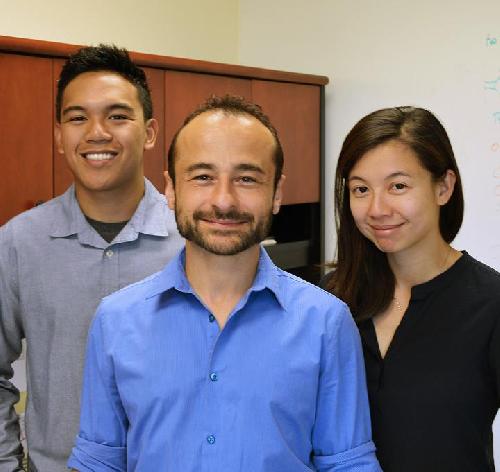LA, JOLLA, CA - April 4, 2016 - A new study led by scientists at The Scripps Research Institute (TSRI) reveals a previously unknown type of immune cell. The discovery opens new avenues in the effort to develop novel therapies for autoimmune diseases such as type 1 diabetes.
The newly discovered cells resemble conventional T cells, yet are biased toward becoming T regulatory cells (Tregs), which protect the body from autoimmune disease.
"This study was eye-opening," said study senior author and TSRI biologist Oktay Kirak. "You wouldn't expect these cells to have this ability. The best analogy I have is Clark Kent turning into Superman. Clark Kent looks like an Average Joe, so no one would expect him to have the same abilities as Superman."
 Authors of the new Scripps Research Institute study include (left to right) Justin Abadejos, Oktay Kirak and Manching Ku. Credit: Photo courtesy of The Scripps Research Institute.
Authors of the new Scripps Research Institute study include (left to right) Justin Abadejos, Oktay Kirak and Manching Ku. Credit: Photo courtesy of The Scripps Research Institute.
The findings are being published the week of April 4, 2016 online ahead of print in the journal Proceedings of the National Academy of Sciences.
Stopping Type 1 Diabetes
The body has an army of millions of immune cells. These cells contain receptors generated through random genetic rearrangements--a clever strategy to keep them ready to fight unfamiliar viruses and bacteria. This diverse pool leaves many questions for scientists, however, about which ones are active in specific diseases.
One puzzling disease is type 1 diabetes, in which immune cells mistakenly attack insulin-producing cells in the pancreas. Scientists know that Tregs should be able control this autoimmune response, deflecting the attack. Current clinical trials are focusing on increasing the numbers of Treg cells and finding ways to make them enter the pancreas.
In the new study, researchers began to solve this problem by isolating an individual Treg from a mouse model of type 1 diabetes and inserting its nucleus--which contained the unique genetic immune receptor information--into a mouse egg cell that had its own nucleus removed.
Using this cloning method (Somatic Cell Nuclear Transfer), the scientists created a mouse model that produced only the original Treg, allowing them to study its origins and functions for the first time.
Unmasking a 'Super' Treg
The scientists found that the Treg originated in a lymphoid organ called the thymus, making it a "naturally" arising Treg, called an nTreg.
After figuring that out, said Kirak, "things got crazy."
The mouse could only make one type of T cells, yet researchers began spotting a second type of T cell in the thymus and spleen. "We realized that the one T cell type exists in two functional states," Kirak said. "That was a huge surprise--I didn't believe it at first."
After repeating their experiment several times, the researchers determined that the two T cell types, while genetically identical, looked different because one of them could switch on a gene called FoxP3. An nTreg with inactive FoxP3 (named a pre-nTreg) looked like any other generic or "conventional" T cell, but when activated, the pre-nTreg became an nTreg.
The researchers think pre-nTregs may be activated in response to many kinds of immune challenges, such as autoimmune diseases, cancer and infections. One of the big questions now is whether a future therapy could push more pre-nTregs to activate and control diseases such as diabetes.
"There are so many things to do now," said Kirak. His lab at TSRI plans to such develop markers to identify different Treg and pre-Treg types. He'd also like to use the cloning technique to investigate immune cells in the body's response to cancers.
source: Scripps Research Institute